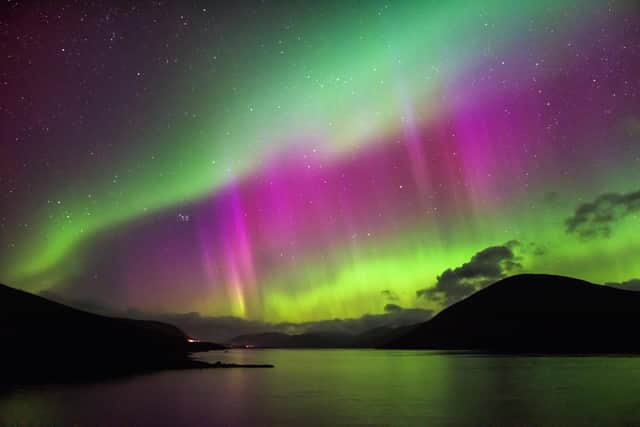Northern Lights visible tonight: How to see Aurora Borealis display from parts of the UK
and live on Freeview channel 276
Stargazers are in for a treat as the Northern Lights are expected to be visible from parts of the UK tonight (March 30). The Met Office has said the Aurora Borealis will be visible tonight and Friday night this week as long as the skies are clear.
The Met Office website explains the Northern Lights occur as a consequence of solar activity and result from collisions of charged particles in the solar wind colliding with molecules in the Earth’s upper atmosphere. This will be the second stunning light display in a month as the Aurora Borealis were visible as far south as Kent and Cornwall for numerous nights in February.
Advertisement
Hide AdAdvertisement
Hide AdKrista Hammond, of the Met Office Space Weather Operations Centre, said: "Minor solar storms are possible on Thursday and Friday night, which means aurora sightings would be possible in northern Scotland under clear skies.
"As this is a fairly minor solar storm, the auroras aren’t expected to be visible much further south on this occasion."
Daniel Verscharen, associate professor in space plasma physics at University College London, said: "Coronal holes are regions from where fast solar wind is launched into space.
"Fast solar wind has speeds of about 700 or 800km per second and is thus almost twice as fast as the average solar wind.
Advertisement
Hide AdAdvertisement
Hide Ad"This particular coronal hole is of interest to us because it has pointed towards Earth - this means that it has released fast solar wind towards the Earth."


Which weather conditions are best to view the Northern Lights?
The Met Office explains the best conditions to view the lights are when the sky is dark and clear of any clouds. Ideally, the lights will be best viewed away from any light pollution, in remote areas, facing the northern horizon - north-facing coasts produce some of the best viewing locations.
The Northern Lights are most active during the Equinox and Solstice in March/April and September/October.
Where can you see the Northern Lights in the UK?
The Northern Lights are most visible in Scotland, North England, North Wales and Northern Ireland. However, under severe space weather conditions, the lights can be seen throughout the UK.
What causes the Northern Lights display?
Advertisement
Hide AdAdvertisement
Hide AdThe Met Office website states the Northern Lights occur as a consequence of solar activity and result from collisions of charged particles in the solar wind colliding with molecules in the Earth’s upper atmosphere.
Solar winds are charged particles that stream away from the Sun at speeds of around 1 million miles per hour. When the magnetic polarity of the solar wind is opposite to the Earth’s magnetic field, the two magnetic fields combine allowing these energetic particles to flow into the Earth’s magnetic north and south poles.
Auroras usually occur in a band called the annulus (a ring about 1,865 miles across) centred on the magnetic pole. The arrival of Coronal Mass Ejections (CME) from the Sun can cause the annulus to expand, bringing the aurora to lower latitudes. It is under these circumstances that the lights can be seen in the UK.
Depending on which gas molecules are hit and where they are in the atmosphere, different amounts of energy are released as different wavelengths of light. Oxygen gives off green light when it is hit 60 miles above the Earth, whilst at 100-200 miles rare, all-red auroras are produced. Nitrogen causes the sky to glow blue yet when higher in the atmosphere the glow has a purple hue.
Comment Guidelines
National World encourages reader discussion on our stories. User feedback, insights and back-and-forth exchanges add a rich layer of context to reporting. Please review our Community Guidelines before commenting.
